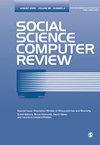Using OpenStreetMap, Census, and Survey Data to Predict Interethnic Group Relations in Belgium: A Machine Learning Approach
IF 2.7
2区 社会学
Q2 COMPUTER SCIENCE, INTERDISCIPLINARY APPLICATIONS
引用次数: 0
Abstract
Neighborhoods are important contexts in shaping interethnic group relationships and sites in which these may materialize through everyday routines in shared local spaces. In this paper, we approach neighborhoods as a small-scale set of spaces of encounter, defined as local public or semi-public spaces, where residents of different ethnic backgrounds may meet. Relying on the classical contact and group threat theories, the main assumption is that local spaces of encounter are facets of an intergroup neighborhood context and may shape intergroup relations, defined as perceived ethnic threat and intergroup friendship. Drawing on the georeferenced survey data from the Belgian National Election Study 2020 enriched with spatial features from OpenStreetMap, an innovative big geospatial data source, and census-based neighborhood characteristics, the study employs machine learning algorithms to investigate whether, which, and how neighborhood spaces of encounter can predict perceived ethnic threat and intergroup friendship, while also taking into account traditional local ethnic, socioeconomic, and individual indicators. By using OpenStreetMap to measure spaces of encounter as a novel neighborhood indicator, we develop a fine-grained typology of local spaces that is rooted in urban and intergroup relations research. The results show that for predicting intergroup friendship, the important spaces were educational, functional, public open, and user-selecting spaces, while for predicting threat functional, third, retail, and other spaces stood out prediction-wise. The results also revealed the predictive importance of individual characteristics for intergroup relations, while neighborhood characteristics were not so important, both in absolute and relative terms. We conclude by reflecting on what local spaces might matter and discuss the combination of OpenStreetMap and intergroup relations as a proof of concept and prospects for future research.利用 OpenStreetMap、人口普查和调查数据预测比利时的族群间关系:机器学习方法
邻里关系是形成族群间关系的重要背景,也是这些关系通过在当地共享空间中的日常例行活动得以具体化的场所。在本文中,我们将邻里作为一个小规模的相遇空间,定义为当地的公共或半公共空间,不同种族背景的居民可能在此相遇。根据经典的接触理论和群体威胁理论,我们的主要假设是,当地的相遇空间是群体间邻里关系的一个方面,并可能塑造群体间关系,即感知到的种族威胁和群体间友谊。本研究利用比利时 2020 年全国选举研究的地理参照调查数据,并结合创新的大地理空间数据来源 OpenStreetMap 的空间特征和基于人口普查的邻里特征,采用机器学习算法研究邻里相遇空间是否、哪些以及如何预测感知到的种族威胁和群体间友谊,同时也考虑到传统的地方种族、社会经济和个人指标。通过使用 OpenStreetMap 来测量作为一种新型邻里指标的相遇空间,我们开发出了一种植根于城市和群体间关系研究的地方空间精细类型学。结果显示,在预测群体间友谊方面,重要的空间是教育空间、功能空间、公共开放空间和用户选择空间,而在预测威胁方面,功能空间、第三空间、零售空间和其他空间在预测方面表现突出。研究结果还揭示了个人特征对群体间关系的重要预测作用,而邻里特征无论从绝对值还是相对值来看都不太重要。最后,我们对哪些本地空间可能重要进行了反思,并讨论了将 OpenStreetMap 与群体间关系相结合的概念验证和未来研究前景。
本文章由计算机程序翻译,如有差异,请以英文原文为准。
求助全文
约1分钟内获得全文
求助全文
来源期刊

Social Science Computer Review
社会科学-计算机:跨学科应用
CiteScore
9.00
自引率
4.90%
发文量
95
审稿时长
>12 weeks
期刊介绍:
Unique Scope Social Science Computer Review is an interdisciplinary journal covering social science instructional and research applications of computing, as well as societal impacts of informational technology. Topics included: artificial intelligence, business, computational social science theory, computer-assisted survey research, computer-based qualitative analysis, computer simulation, economic modeling, electronic modeling, electronic publishing, geographic information systems, instrumentation and research tools, public administration, social impacts of computing and telecommunications, software evaluation, world-wide web resources for social scientists. Interdisciplinary Nature Because the Uses and impacts of computing are interdisciplinary, so is Social Science Computer Review. The journal is of direct relevance to scholars and scientists in a wide variety of disciplines. In its pages you''ll find work in the following areas: sociology, anthropology, political science, economics, psychology, computer literacy, computer applications, and methodology.
 求助内容:
求助内容: 应助结果提醒方式:
应助结果提醒方式:


